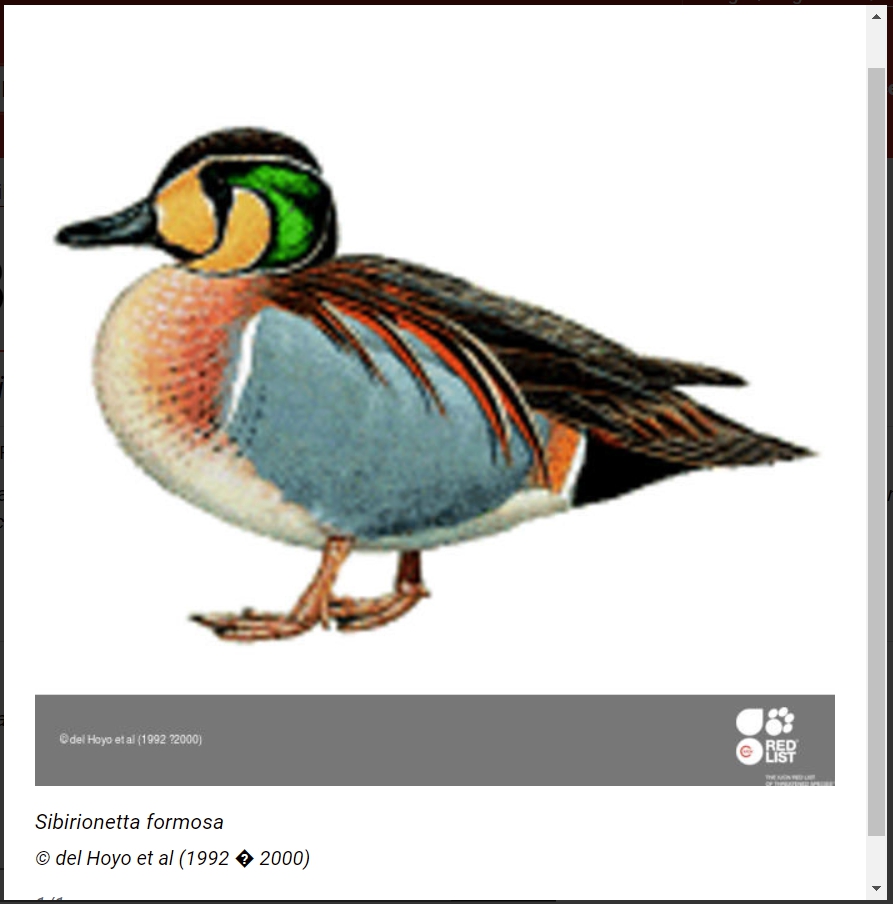| Taxon ID: 86,993 Total records: 39,143 | ||||||||||||||
Sibirionetta formosa
Country
| Country | Philippines |
|---|---|
| Continent Ocean | Asia |
Classification
| Kingdom | Animalia (COL) |
|---|---|
| Phylum | Chordata (COL) |
| Class | Aves (COL) |
| Order | Anseriformes (COL) |
| Family | Anatidae (COL) |
Taxonomy
| Genus | Sibirionetta | Reference | |
|---|---|---|---|
| SubGenus | Vernacular Name | ||
| Species | formosa | IUCN Threat Status-Year | Least Concern, 2016 |
| SubSpecies | Nat'l Threat Status-Year | Not Evaluated, 2022 | |
| Infraspecies | Reason for Change | ||
| Infraspecies Rank | CITES | ||
| Taxonomic Group | Birds | Native Status | Native |
| Scientific Name Author | (Georgi, 1775) | Country Distribution | Philippines; |
| Citation | BirdLife International. 2016. Sibirionetta formosa. The IUCN Red List of Threatened Species 2016: e.T22680317A92855272. https://dx.doi.org/10.2305/IUCN.UK.2016-3.RLTS.T22680317A92855272.en. Accessed on 16 March 2022. Brinkman, J.J., van der Ven, W., Allen, D., Hutchinson, R., Jensen, A.E., Perez, C. (2021): Checklist of birds of the Philippines. Wild Bird Club of the Philippines. www.birdwatch.ph | Description | JUSTIFICATION
This species is listed as Least Concern as its population is now growing rapidly and has not undergone the once-predicted declines. Despite its current population trend, the species remains potentially threatened by a number of factors. It tends to congregate in very large flocks, and suffered rapid declines in many parts of its range during the twentieth century because of hunting and other threats. Its roost sites are unprotected, large numbers died in a recent disease outbreak, and most importantly, the dry rice paddies where it feeds are being converted to vegetable farms and other uses. If evidence arises in the future that these threats have begun to drive a decline, the species may warrant uplisting.
RANGE DESCRIPTION
Sibirionetta formosa breeds in eastern Siberia, Russia and occurs on passage in Mongolia and North Korea. It winters mainly in Japan, South Korea, which now holds the majority of the wintering population, and mainland China, and it is a rare winter visitor to Taiwan (China) and Hong Kong (China). In the early 20th century, it was one of the most numerous ducks in eastern Asia and flocks of many thousands were regularly reported, but a significant decline took place since the 1960s and 1970s. Since then however, wintering counts in South Korea have increased spectacularly from the c.20,000 located in the 1980s to a total of 658,000 recorded during simultaneous surveys in 2004, including c. 600,000 in the lower reaches of the Geum River, and a staggering total of c.1.06 million counted in January 2009 (Moores et al. 2010, N. Moores in litt. 2010), with concentrations of over 20,000 at six different sites (N. Moores in litt. 2010). In support of the view that a genuine population increase has taken place in South Korea, an analysis of counts conducted at 38 sites every year since 1999 indicate an increase from a yearly average of 11,533 in 1999-2003 to a yearly average of 314,994 in 2005-2009 (N. Moores in litt. 2010). The increase in the South Korean wintering population is believed to be linked an increase in newly reclaimed land as well as a decline in hunting pressure (Moores 1996, Moores et al. 2010, N. Moores in litt. 2010). In January 2006 a flock of 8,000-10,000 individuals was noted at the small Chongming Dongtan Ramsar Site in China (where the previous maximum was 300 individuals) and in 2006/2007 a flock of 50,000 was recorded at Yancheng National Nature Reserve; these represent the largest flocks recorded outside of South Korea in recent years (Zhang Kejia in litt. 2006, Zhang 2006). The total national population estimate has since been placed at 91,000 individuals (Cao et al. in prep.). The species has continued to increase its numbers and range in China (Lei Cao and M. Barter in litt. 2010), and a possibly slow increase in the population has been noted in Japan since the 1990s, albeit with some fluctuation in numbers (Hironobu Tajiri in litt. 2011).
DESCRIPTION
The 2004 Asian Waterbird Census estimated the population in Korea at 455,000 individuals (D. Li in litt. 2005; Wetlands International 2006). A separate study in 2004 reported 658,000 individuals in Korea (Hansoo Lee in litt. 2004), but this could be an over-estimate. Further to this, Brazil (2009) has estimated national population sizes at |
| Source |
Record Level
| Date Last Modified | 2022-03-18 04:01:18 |
|---|---|
| Institution Code | ACBBISS-PH |
| Collection Code | 86991 |
| Catalog Number | ACBBISS-PH-86991 |
| Record URL | https://www.iucnredlist.org/species/22680317/92855272 |
Growth Parameters
Collecting Event
Images
|
Additional Info
Synonyms To Manage Synonyms for Sibirionetta formosa, click this link: Synonyms. |
Anas formosa Georgi, 1775 |
Common Names To Manage Common Names for Sibirionetta formosa, click this link: Common Names. |
|
Localities To Manage Localities for Sibirionetta formosa, click this link: Localities. |
Species Record Details Encoded By:
Carlos Aurelio Callangan
|
Species Record Updated By:
Carlos Aurelio Callangan
|

